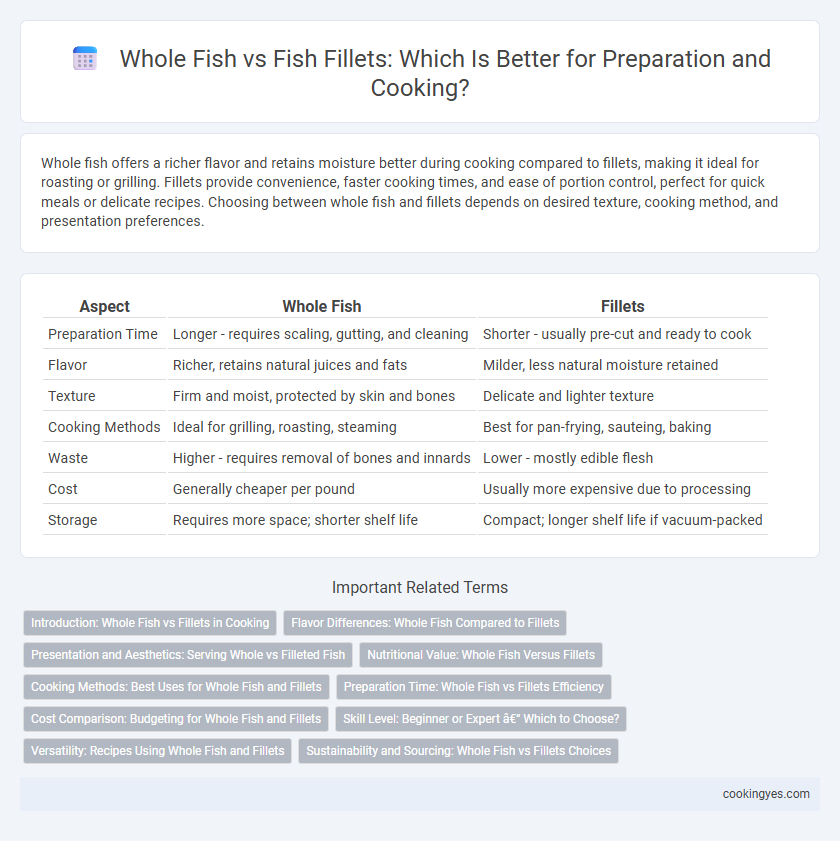Whole fish offers a richer flavor and retains moisture better during cooking compared to fillets, making it ideal for roasting or grilling. Fillets provide convenience, faster cooking times, and ease of portion control, perfect for quick meals or delicate recipes. Choosing between whole fish and fillets depends on desired texture, cooking method, and presentation preferences.
Table of Comparison
| Aspect | Whole Fish | Fillets |
|---|---|---|
| Preparation Time | Longer - requires scaling, gutting, and cleaning | Shorter - usually pre-cut and ready to cook |
| Flavor | Richer, retains natural juices and fats | Milder, less natural moisture retained |
| Texture | Firm and moist, protected by skin and bones | Delicate and lighter texture |
| Cooking Methods | Ideal for grilling, roasting, steaming | Best for pan-frying, sauteing, baking |
| Waste | Higher - requires removal of bones and innards | Lower - mostly edible flesh |
| Cost | Generally cheaper per pound | Usually more expensive due to processing |
| Storage | Requires more space; shorter shelf life | Compact; longer shelf life if vacuum-packed |
Introduction: Whole Fish vs Fillets in Cooking
Whole fish preserves natural moisture and flavor during cooking, offering a richer taste experience and more versatile presentation options. Fillets provide convenience, quicker preparation, and easier portion control, making them ideal for recipes requiring precise cooking times. Selecting between whole fish and fillets depends on culinary goals, recipe requirements, and personal preference for texture and flavor intensity.
Flavor Differences: Whole Fish Compared to Fillets
Whole fish retains the natural flavor and moisture during cooking due to bones and skin, enhancing taste and texture. Fillets tend to be milder and less oily, resulting in a more delicate but sometimes less flavorful experience. Cooking methods like roasting or grilling whole fish preserve rich, intense flavors that can be lost when using fillets.
Presentation and Aesthetics: Serving Whole vs Filleted Fish
Serving whole fish offers a visually striking presentation, showcasing the fish's natural shape, scales, and head, which can enhance the dining experience through its authenticity and elegance. Filleted fish provides a cleaner, more refined appearance that highlights the fish's flesh, making it easier to plate with complementary garnishes for a minimalist and sophisticated look. Chefs often choose whole fish for dramatic table presentation and fillets for contemporary plating styles that emphasize texture and color contrasts.
Nutritional Value: Whole Fish Versus Fillets
Whole fish retains skin, bones, and organs that provide essential nutrients like omega-3 fatty acids, calcium, and collagen, often lost in fillets. Fillets offer convenience and lower fat content but may lack some micro-nutrients concentrated in the fish's frame and skin. Choosing whole fish enhances intake of vital minerals and antioxidants beneficial for bone health and skin integrity.
Cooking Methods: Best Uses for Whole Fish and Fillets
Whole fish retains moisture and flavor during roasting, grilling, or steaming, making it ideal for dishes where presentation and texture are key. Fillets, with their uniform thickness, cook quickly and evenly, perfect for pan-frying, sauteing, and baking. These preparation differences optimize cooking efficiency and final taste based on the chosen method.
Preparation Time: Whole Fish vs Fillets Efficiency
Fillets significantly reduce preparation time by eliminating the need for scaling, gutting, and deboning, allowing for quicker cooking. Whole fish require additional cleaning and careful handling, which can double the prep duration compared to fillets. Choosing fillets enhances efficiency in fast-paced culinary environments, making them the preferred option for time-sensitive meals.
Cost Comparison: Budgeting for Whole Fish and Fillets
Whole fish typically offer a more cost-effective option compared to fillets, as they include bones, skin, and heads that increase total edible weight and culinary versatility. Fillets, while more convenient and time-saving, often come with a higher price per pound due to the butchering and processing involved. Budget-conscious buyers can reduce costs by purchasing whole fish and utilizing the entire fish for multiple dishes, minimizing waste and maximizing value.
Skill Level: Beginner or Expert – Which to Choose?
Whole fish requires more advanced skills for cleaning, scaling, and deboning, making it better suited for expert cooks who want to maximize flavor and presentation. Fillets offer convenience and ease of preparation, ideal for beginners seeking quick, manageable cooking without extensive knife skills. Choosing between whole fish and fillets depends on the cook's confidence and desired complexity in the kitchen.
Versatility: Recipes Using Whole Fish and Fillets
Whole fish offers exceptional versatility, lending itself to roasting, grilling, steaming, and baking while preserving moisture and flavor through intact bones and skin. Fillets provide convenience and speed, ideal for pan-frying, sauteing, and quick-cooking methods, making them perfect for diverse recipes like fish tacos, ceviche, and delicate poached dishes. Both whole fish and fillets allow for creative seasoning and pairing with herbs, citrus, and sauces, enhancing the culinary experience based on texture preferences and preparation time.
Sustainability and Sourcing: Whole Fish vs Fillets Choices
Choosing whole fish over fillets supports sustainability by reducing waste and encouraging the use of the entire catch, promoting responsible sourcing practices. Whole fish retains more nutrients and allows consumers to verify freshness, while fillets often come from industrial processing with potential overfishing risks. Opting for locally sourced whole fish from certified sustainable fisheries enhances traceability and minimizes environmental impact compared to mass-produced fillets.
Whole fish vs Fillets for preparation Infographic

 cookingyes.com
cookingyes.com